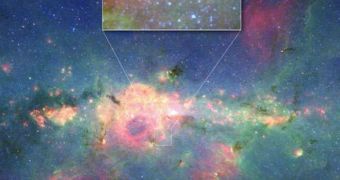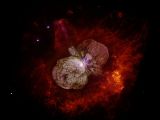Eta Carinae is still viewed by most astronomers as the galaxy's brightest known star, albeit lately a new contender for that title was discovered in the Peony nebula, towards the Milky Way's center. Now, NASA's Spitzer Space Telescope pierced through one of the dustiest regions of the galaxy to show exactly how bright the Peony nebula star is.
Measurements revealed that it radiates an amount of energy equivalent to about 3.2 million times the total output of the Sun, a little under the light of 4.7 million Suns generated by Eta Carinae, meaning that the star in the Carina constellation still remains the most luminous that we know of. At least for now, since measuring the brightness of a star is rather difficult and although two stars appear to have different brightness levels, they could in fact generate identical amounts of light.
"As we get better measurements, these things change around a bit," says Michelle Thaller at NASA's Jet Propulsion Laboratory in California.
Maybe we haven't even found the brightest star in the galaxy. "There are probably other stars just as bright if not brighter in our galaxy that remain hidden from view," says Lidia Oskinova of Potsdam University, lead author of the study.
Eta Carinae as well as the Peony nebula star are hypergiant luminous blue variable stars, with masses ranging somewhere between 100 and 200 times that of the Sun. Hypergiant stars burn fuel at incredibly fast rates, have lives several tens of times shorter in comparison to our Sun and could turn 'nova' at just about any moment in time.
Eta Carinae is relatively close to our position, at about 7,500 light years away, while the Peony nebula star is located at about 26,000 light years away. "For all we know, they may have already blown themselves up and we're just waiting for the light to get to us to tell us that," said Thaller.
It might appear that knowing which blue star in the galaxy is the brightest is an important matter, albeit astronomers are in fact more willing to know how hypergiant stars influence the evolution of the galaxy. "These are real drivers of a galaxy's life cycle. When these things go off, they will probably kick off a new generation of stars," she said.

 14 DAY TRIAL //
14 DAY TRIAL // 
